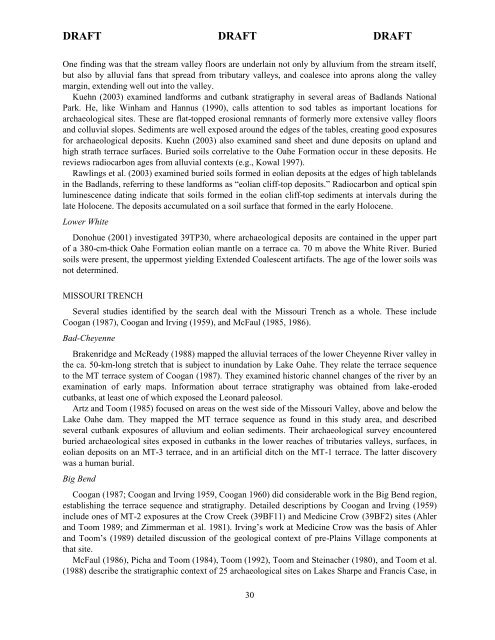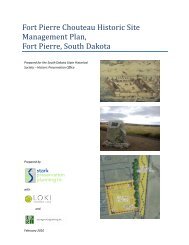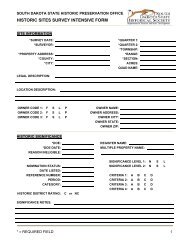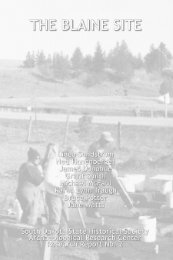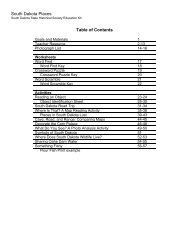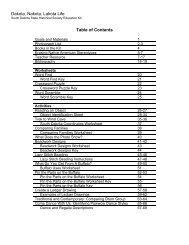A Geoarchaeological Overview of South Dakota and Preliminary
A Geoarchaeological Overview of South Dakota and Preliminary
A Geoarchaeological Overview of South Dakota and Preliminary
Create successful ePaper yourself
Turn your PDF publications into a flip-book with our unique Google optimized e-Paper software.
DRAFT DRAFT DRAFT<br />
One finding was that the stream valley floors are underlain not only by alluvium from the stream itself,<br />
but also by alluvial fans that spread from tributary valleys, <strong>and</strong> coalesce into aprons along the valley<br />
margin, extending well out into the valley.<br />
Kuehn (2003) examined l<strong>and</strong>forms <strong>and</strong> cutbank stratigraphy in several areas <strong>of</strong> Badl<strong>and</strong>s National<br />
Park. He, like Winham <strong>and</strong> Hannus (1990), calls attention to sod tables as important locations for<br />
archaeological sites. These are flat-topped erosional remnants <strong>of</strong> formerly more extensive valley floors<br />
<strong>and</strong> colluvial slopes. Sediments are well exposed around the edges <strong>of</strong> the tables, creating good exposures<br />
for archaeological deposits. Kuehn (2003) also examined s<strong>and</strong> sheet <strong>and</strong> dune deposits on upl<strong>and</strong> <strong>and</strong><br />
high strath terrace surfaces. Buried soils correlative to the Oahe Formation occur in these deposits. He<br />
reviews radiocarbon ages from alluvial contexts (e.g., Kowal 1997).<br />
Rawlings et al. (2003) examined buried soils formed in eolian deposits at the edges <strong>of</strong> high tablel<strong>and</strong>s<br />
in the Badl<strong>and</strong>s, referring to these l<strong>and</strong>forms as “eolian cliff-top deposits.” Radiocarbon <strong>and</strong> optical spin<br />
luminescence dating indicate that soils formed in the eolian cliff-top sediments at intervals during the<br />
late Holocene. The deposits accumulated on a soil surface that formed in the early Holocene.<br />
Lower White<br />
Donohue (2001) investigated 39TP30, where archaeological deposits are contained in the upper part<br />
<strong>of</strong> a 380-cm-thick Oahe Formation eolian mantle on a terrace ca. 70 m above the White River. Buried<br />
soils were present, the uppermost yielding Extended Coalescent artifacts. The age <strong>of</strong> the lower soils was<br />
not determined.<br />
MISSOURI TRENCH<br />
Several studies identified by the search deal with the Missouri Trench as a whole. These include<br />
Coogan (1987), Coogan <strong>and</strong> Irving (1959), <strong>and</strong> McFaul (1985, 1986).<br />
Bad-Cheyenne<br />
Brakenridge <strong>and</strong> McReady (1988) mapped the alluvial terraces <strong>of</strong> the lower Cheyenne River valley in<br />
the ca. 50-km-long stretch that is subject to inundation by Lake Oahe. They relate the terrace sequence<br />
to the MT terrace system <strong>of</strong> Coogan (1987). They examined historic channel changes <strong>of</strong> the river by an<br />
examination <strong>of</strong> early maps. Information about terrace stratigraphy was obtained from lake-eroded<br />
cutbanks, at least one <strong>of</strong> which exposed the Leonard paleosol.<br />
Artz <strong>and</strong> Toom (1985) focused on areas on the west side <strong>of</strong> the Missouri Valley, above <strong>and</strong> below the<br />
Lake Oahe dam. They mapped the MT terrace sequence as found in this study area, <strong>and</strong> described<br />
several cutbank exposures <strong>of</strong> alluvium <strong>and</strong> eolian sediments. Their archaeological survey encountered<br />
buried archaeological sites exposed in cutbanks in the lower reaches <strong>of</strong> tributaries valleys, surfaces, in<br />
eolian deposits on an MT-3 terrace, <strong>and</strong> in an artificial ditch on the MT-1 terrace. The latter discovery<br />
was a human burial.<br />
Big Bend<br />
Coogan (1987; Coogan <strong>and</strong> Irving 1959, Coogan 1960) did considerable work in the Big Bend region,<br />
establishing the terrace sequence <strong>and</strong> stratigraphy. Detailed descriptions by Coogan <strong>and</strong> Irving (1959)<br />
include ones <strong>of</strong> MT-2 exposures at the Crow Creek (39BF11) <strong>and</strong> Medicine Crow (39BF2) sites (Ahler<br />
<strong>and</strong> Toom 1989; <strong>and</strong> Zimmerman et al. 1981). Irving’s work at Medicine Crow was the basis <strong>of</strong> Ahler<br />
<strong>and</strong> Toom’s (1989) detailed discussion <strong>of</strong> the geological context <strong>of</strong> pre-Plains Village components at<br />
that site.<br />
McFaul (1986), Picha <strong>and</strong> Toom (1984), Toom (1992), Toom <strong>and</strong> Steinacher (1980), <strong>and</strong> Toom et al.<br />
(1988) describe the stratigraphic context <strong>of</strong> 25 archaeological sites on Lakes Sharpe <strong>and</strong> Francis Case, in<br />
30


